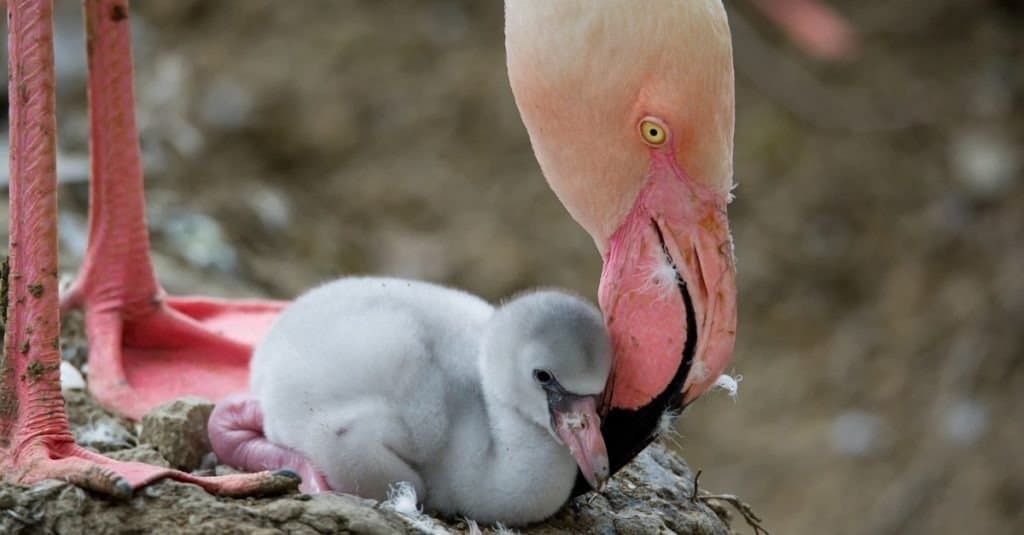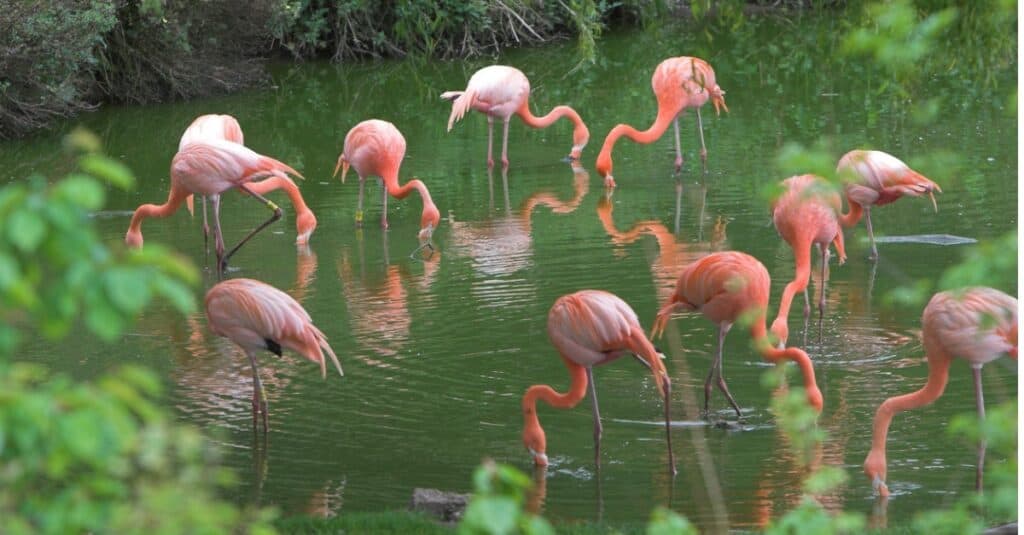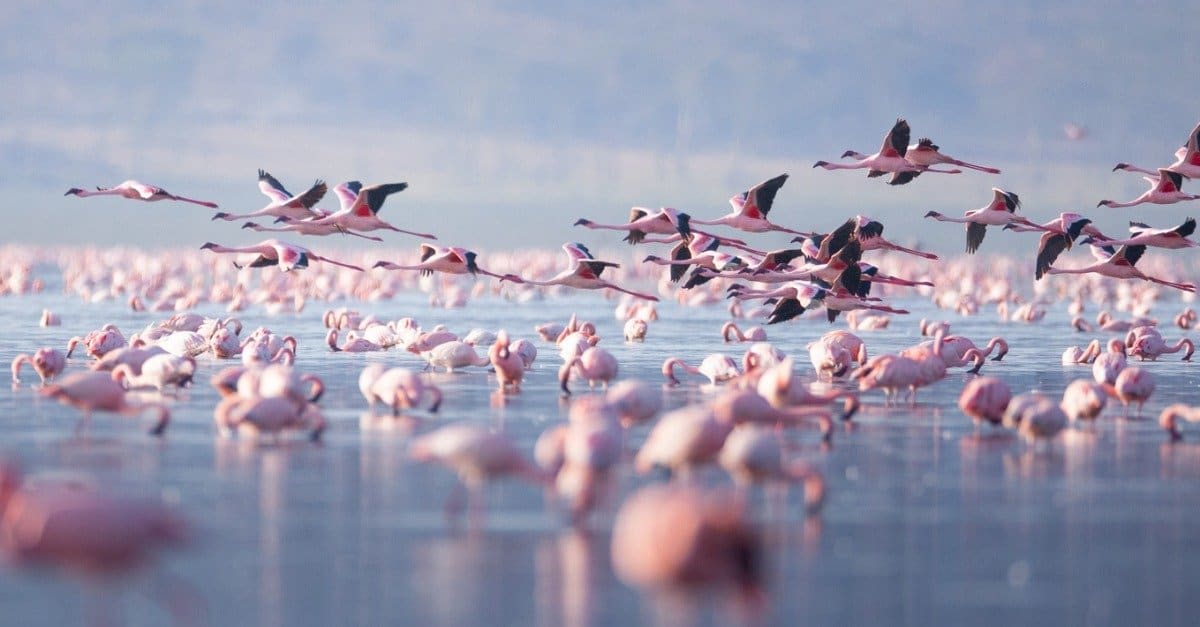Who doesn’t love flamingos? These strange, almost otherworldly birds can be found all around the world, and they’re definitely hard to miss. One might notice that when there is one flamingo, there is usually a large group of flamingos. These are not solitary animals! So what exactly is a group of flamingos called?
In this guide, we’ll take a look at what a group of flamingos is called and how their group dynamics work. We’ll also explore what additional terms are used to refer to flamingo groups, including baby flamingos. But first, let’s look at a solid definition of what a flamingo actually is.
What is a Flamingo?
The iconic wading birds called flamingos are distinguished by their bright pink coloring and long, thin legs. They are mostly linked to shallow, saline, or alkaline lakes or estuaries. Flamingos can be found in areas of Africa, Asia, the Americas, and Europe.
Being social birds, flamingos often gather in big flocks that might number in the thousands. They forage for tiny crustaceans, mollusks, and other aquatic invertebrates using their long, thin legs to wade through shallow water. These aquatic invertebrates are then filtered out of the water using a unique filtering mechanism called a lamellae in their beaks.
The pink color of flamingos, which results from pigments in the algae and other aquatic creatures they eat, is one of their most recognizable characteristics. Their hue can range from pale pink to deep red in intensity, depending on the availability of these pigments in their food.
Intriguing breeding practices are another characteristic of flamingos. Usually, they use mud to construct their nests, and the male and female alternate turns caring for the eggs. When the eggs hatch, glands in the digestive tracts of the parents create a specific milk that is supplied to the chicks. The milk’s rich protein and fat content aids in the chicks’ quick growth.
Flamingos have a significant place in human culture and mythology in addition to their distinctive physical traits and reproductive patterns. They are viewed as representations of elegance, beauty, and flamboyance. Which, interestingly enough, brings us to what a group of flamingos is called.
Flamingo Flamboyance: All in the Family
Most people recognize flamingos as an iconic breed of bird, but because of where they live, significantly fewer people have actually seen one (or more) in person. There are actually six different species of flamingos, all of which are delightful and sociable birds that usually congregate in large numbers. To describe groups of flamingos, a number of self-explanatory collective nouns are routinely employed.
A flamboyance of flamingos is the most common term that refers to a group of flamingos. A group of flamingos may also be known as a colony of flamingos or a stand of flamingos as well, though “flamboyance” is the most common term. The term flamboyant, which derives from an old French word that originally meant “flame,” is widely used in English to denote something that is stylish, colorful, bright, dazzling, and flashy, all adjectives that perfectly capture our perception of the majestic flamingo. Interestingly, the Latin term “flamma,” which also means flame or fire, is where the name “flamingo” originates.
The collective word “colony of flamingos” is commonly used to refer to a group of flamingos since their preferred habitats, which typically have exceptionally high salt concentrations, are often rejected by other species and animals. Therefore, the flamingos arrive in the area and settle there, establishing a colony by definition.
It is quite likely that the term “stand of flamingos” came from seeing these birds’ propensity for standing still and resting for extended periods of time, usually on one leg, which is an amazing sight when observed in huge groups.

A flock of flamingos (pictured) is typically referred to as a flamboyance of flamingos.
©Roxane 134/Shutterstock.com
Other Terms for a Group of Flamingos
A regiment of flamingos is another simple collective word for a group of flamingos. This term derives from their propensity to congregate and march in time like a squad of disciplined soldiers.
The lesser flamingo, a species native to Africa, boasts the biggest reported flock of birds known to man and is said to be so friendly that groups of up to a million individuals have been observed breeding together. When a huge number of flamingos ascend into the air by sprinting across a lake’s surface and flapping their large rose-colored wings to lift up, one can only imagine the commotion and joy the sight could bring! This event could also be the source of the additional group name “a flurry of flamingos.”
While not a common collective word, “a skein of flamingos” is occasionally used, especially with flying birds. Flamingos in flight are most often categorized using the straightforward word “flock,” which is applicable to the majority of bird species.
There have been tales of the collective phrase “a veton of flamingos.” However, its history is murky. It appears to have its roots in the Albanian term for lightning and is typically thought of as a rare boys’ name. It is not very common when used to refer to flamingos.
What is the Term for a Group of Baby Flamingos?
Baby flamingos are variously referred to as chicks, hatchlings, or a creche of flamingos depending on their age. This latter term describes how parents raise a single chick before handing it off to a group. The group is watched over and guarded by a few adult flamingos during the day, but the chicks return to their parents at night and during feeding time, much like young children who attend a creche or kindergarten.

Baby flamingos (pictured) are cared for by their parents in large groups or a creche of baby flamingos.
©Ondrej Chvatal/Shutterstock.com
What is a Pair of Flamingos Called?
Many flamingos have lifelong partners. These monogamous couples remain together as long as they are able to have babies. Many flamingos reproduce for more than 30 years. However, flamingos in flocks of tens of thousands of birds may switch mates from one season to the next.
Flamingo pairs do not have distinct names. This is probably because they are frequently observed in flocks rather than as a single basic couple. All mating partners construct nests together throughout the breeding season as opposed to dispersing into various locations.
Since all flamingos reproduce at the same time, flamingos court for a brief period to start the mating season. Males and females build their nests together out of mud. However, they usually prefer to take one that another couple has already made. While their egg is being incubated, flamingos vigorously protect their nest.
Why Flamingos Live in Large Groups
Flamingos dwell in groups for a variety of reasons, including safety. They are occasionally prey to crocodiles, eagles, and other large birds of prey. Flamingos can ward against predators by living in flocks because they seem more intimidating and challenging to kill.
Flamingos are also noted for being attentive. As they live in groups, they can notify one another of danger and take appropriate evasive action when necessary. While coyotes, foxes, eagles, and other birds of prey attack newborn flamingos, adult flamingos are rarely in danger from predators. The baby chicks are protected from predators by these flocks.
Flamingo Breeding
Flamingos dwell in groups for breeding purposes as well. They are monogamous birds with lifelong partners and can build massive breeding colonies with hundreds of birds. Flamingos can improve their chances of finding a partner and successfully rearing their young by residing in big groups. Individuals in breeding colonies perform courting rituals. They also collaborate on nest construction and alternate incubating their eggs to increase the chances that their young will survive.
Particularly in places with limited nesting space, flocks of flamingos had greater brood success rates than single flamingos. Several adults watch over young flamingos from numerous parents. The young flamingos are better protected by this collective babysitting activity.
Foraging for Food
Flamingos have increased access to food resources when they live in groups as well. The main food that flamingos consume is tiny crustaceans like shrimp and algae. Flamingos filter these creatures out of the water with the help of their specialized bills. Flamingos can find and use food resources more effectively when they live in huge flocks. They can also take advantage of the flushing effect that happens when big flocks of birds pass through the water. The bottom sediment is stirred up by this flushing process, which also releases more food particles into the water. This makes the food easier for flamingos to capture.

Flamingos (pictured) have a better chance at finding food when foraging in groups.
©iStock.com/GTMedia
Do Male Flamingos Live in a Flamboyance?
Yes! Male flamingos do live in flamboyances or flocks. As sociable creatures, flamingos are renowned for their tendency to congregate in massive groups. They flocks may number in the thousands. Males and females may both be present in these flocks. Within the main flock, the males will sometimes form smaller subgroups.
Male flamingos generally participate in elaborate wooing rituals to entice a partner during the breeding season. These performances might include vocalizations, coordinated dancing, and other actions meant to wow the lady birds. Once a pair has developed a relationship, they will cooperate to construct a nest and care for their offspring.
Male flamingos are not normally violent against other males. If they feel that their territory or mate is in danger, they may become aggressive during the mating season. The majority of the time, though, males will happily cohabit with one another within the flock.
Generally speaking, flamingos are extremely social birds that depend on the protection and assistance of the flamboyance to survive. They interact with one another by using a range of vocalizations and body language. Flamingos frequently cluster together to avoid being eaten by predators and to keep warm.
How Many Flamingos Live in an Average Flamboyance?
A flamingo flock’s size can fluctuate significantly depending on a number of variables. Some variables include the availability of food and water, breeding habits, and habitat conditions. Flamingos are very sociable creatures that gather in big flocks that can number in the thousands.
In Tanzania’s Lake Natron, flocks of flamingos can number more than a million birds. This makes it the most well-known and biggest breeding colony in the world. In contrast, flocks in other regions could only include a few hundred members. Because of this, the size of a flock of flamingos can change depending on the situation. There is no set number of flamingos in a flock. However, there can be hundreds to even millions of birds per flamboyance.
Flamingos are delightful birds that live in massive flocks or flamboyances. If you spot a flamingo in the wild, chances are you’ll see a few hundred more as well!
Thank you for reading! Have some feedback for us? Contact the AZ Animals editorial team.








